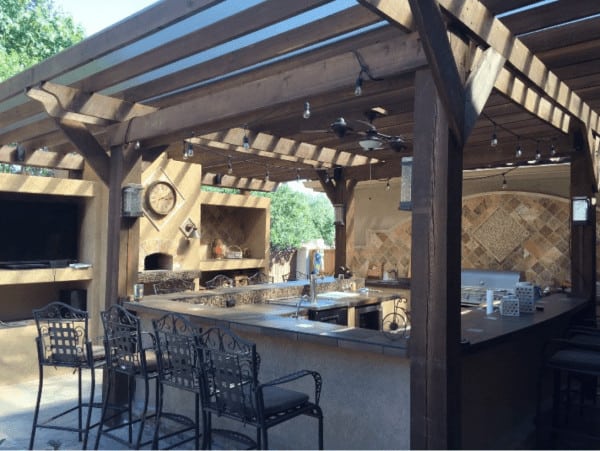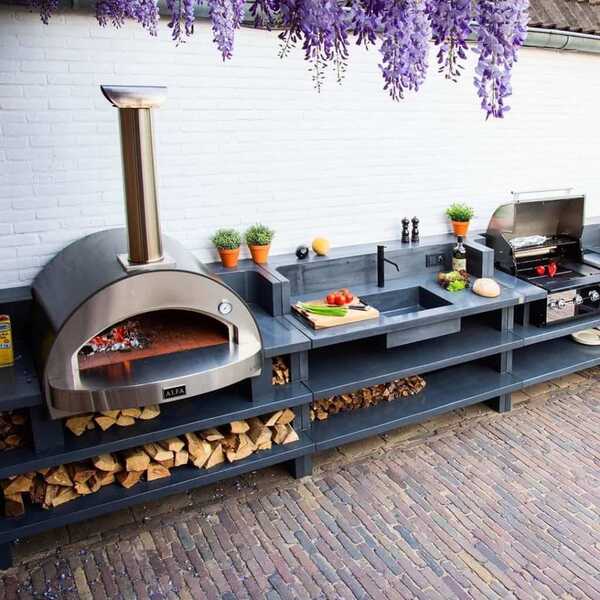Considerations for adding an outdoor kitchen
-
Considerations for adding an outdoor kitchen
Considerations for adding an outdoor kitchen, an outdoor kitchen is a natural place to gather in a landscape.
After all, everyone ends up in a kitchen inside, so chances are high that the same thing will happen when there is a kitchen outside.
The outdoor kitchen encourages you to enjoy dining al fresco when the weather is good,
whether or not you have guests, and when it’s time for entertainment on a larger scale, the outdoor kitchen allows you to be a part of the party.
Adding an outdoor kitchen is a big task in terms of time and cost, and before you start you can consider adding an outdoor kitchen in stages.
There are a lot of pieces to consider for an outdoor kitchen, even if you’re on a small, simple project, so it’s important to find the right professionals.
And if your kitchen is part of a new landscape plan or cornerstone of a landscape upgrade, you should work with a landscape architect or landscape designer.
Companies that sell outdoor devices and materials often have a designer who can help you determine the design and features you need and can advise how to achieve this.
A licensed general contractor with experience in building outdoor kitchens can ensure that the installation is done correctly,
and you will need to hire a licensed plumber and licensed electrician for any plumbing or electrical work.
Before getting to the actual design, think about exactly where your outdoor kitchen will go in your yard,
the perfect size and layout of the space and the overall look and feel you want.

Climatic factors
One of the first things to consider are climate factors. If the summer is hot, humid, rainy or short-lived,
the real amount of time you spend using the kitchen may be limited ‘which means that the cold climate and winters also have additional maintenance to prepare the space for winter.
Your lifestyle
The second consideration is the type of outdoor kitchen that is appropriate for your lifestyle.
Is your family large or small? Do you have a lot of fun or do you throw big parties with a lot of people?
Perhaps the simpler design will make your current space more efficient and more convenient for you,
the space should be functional and hardworking and most of all, it should be a place you are happy to be and show off.
Where will you put the kitchen?
An outdoor kitchen should be accessible and easy to use, usually designers locate an outdoor kitchen near the most used exit from the house,
such as a family room or kitchen, as proximity and ease of use make for a good design.
It should also be near the back door, for ease of taking food out or for cleaning,
and most people may want to hide their outside kitchens from interior lines of sight.
We do not advise you to do so, on the contrary, fully display it to entice yourself and your visitors to hang out and play.
There are times when moving an outdoor kitchen away from home might make more sense,
if you have an outdoor dining or relaxing area, locating a nearby kitchen makes it easy to serve food and drinks and adds to the ambience of outdoor living.
Placing a kitchen space near a pool or other destination on your patio may entice people to explore and appreciate the rest of the landscape.
And if your home opens directly to a heavily used area where a lot of people interact,
and especially a children’s play area, then locating the kitchen a little further away from the action will give you a safer place to prepare food.
The microclimate in your yard will also be a factor, so choosing a place that doesn’t get too much wind will make your outdoor kitchen more comfortable.
Unless you want to add a roof or upper shade structure, a site that receives direct sunlight can be very hot,
and a very shaded spot may be uncomfortable for several months of the year.

-
Size and layout
Even the smallest outdoor kitchen designed for a single cook will need enough space to prepare, cook, serve and start cleaning,
and if more than one person uses the space, you need enough space for everyone to move comfortably.
Designs that work well in interior kitchens will be equally employed on the outside,
looking at the pros and cons of each can help you determine what works best for your space and needs.
-
Design style
An outdoor kitchen is a great way to showcase your landscape design style.
You can opt for a traditional look with classic brickwork, a Mediterranean style that features stucco finishes, granite countertops, and a pizza oven.
Or an outdoor paradise inspired by the tropics,
keeping in mind that all spaces should be harmonious, just like the interior of your home.
Deciding what you want in your outdoor kitchen can be overwhelming,
because of course you’ll need a grill, but would having two be better?
What is the best choice for a cooling system? And should you add a sink or not?
To narrow down the list, first focus on what makes sense for you and your family.
You can always plan to make it possible to add more to the design in the future
-
Grills and other cooking items
The built-in grill is the base in an outdoor kitchen, and choosing the right grill for what you want to cook it,
how you want to cook it, and who you want to cook for is the starting point.
Cooling
The full or bottom fridge makes storing cold drinks easy and keeping food from spoiling.
The idea of adding the freezer “either separately or as part of the cooling unit” gives you a place for ice cubes, ice cream and other frozen desserts.
You can add a beverage unit in the fridge, and place it near the end of the counter,
in this case your family and guests can easily access the drinks of their choice without hindering food preparation.
Sinks and faucets
The sink gives you a place to wash food before cooking, wash vegetables straight from the garden or even soak a frying pan or two.
The stainless steel tub is weatherproof and easy to care for, although it can get hot and reflective in direct sunlight.
Other material options for the outdoor sink also include stone, concrete, and forged metals such as copper or nickel.
Whatever material you choose, make sure it is suitable for outdoor use.
Fortunately, most drains are easy to take care of since you can add a cover to keep dirt and debris out when not in use.
But installing the sink is not as simple as it may seem, especially if you want hot and cold water.
You will need to run both supply lines and add a drain line and may need to add a small hot water heater.

Additional storage space
Extra drawers, boxes or cabinets can hold everything from barbeques, plates, and serving pieces to mugs and silverware.
Also, stain garbage and recycling make cleaning much easier, and put the paper towel holder on the work surface or put it in the door.
And if you have a grill, have a small pantry area or spice rack in your design.
Once you choose the appliances and define the other elements that will form the core of your outdoor kitchen, you need to put it all together.
This is where worktops and plinths or cabinets come into play, as counters and base materials will define the look and feel of the space.
Countertops
There are a number of material options that can top your outdoor kitchen,
and stone remains the most popular choice for outdoor countertops.
Durable and beautiful, it can handle spills, stains, and outdoor elements,
and the wood worktop fits into almost any style, from traditional to contemporary, and its organic character complements most landscape designs.
Concrete has also become a preferred material for outdoor worktops,
especially when paired with contemporary landscape design, and tiles can also be another option for countertops.
Base bases and cabinets
These are the backbone of your kitchen and define the total space and store your grill or carry cabinets, drawers, fridges, and sinks.
Plinths and plinth cabinets need to be endurable, because you will be preparing and serving food on them and possibly using them as a dining space,
so you will need materials that can withstand heavy use, spills and weathering.
The professional will manufacture the basic structure, including adding the necessary insulation and flame retardant materials.
The next step will be to add the features you want and cover them.
Finishes can range from brick and wood to plaster, concrete, metal, and natural materials such as bamboo.
Lighting
If an outdoor kitchen is combined with dining or sitting areas,
this will invite you to stay outside until the evening, so get the proper lighting as this will make a big difference.
Of course you want the barbecue and food prep areas to be well lit,
and corridors and transitional areas may not need a great deal of direct lighting, but there should be enough to make moving around safe and easy.
Soft and subtle ambient lighting in the dining and gathering areas can help set the mood while allowing you to enjoy the changing natural light at twilight time.
While you can limit yourself to string lights, a wall-mounted sconce or two,
and a task lamp by the grill, having a lighting plan when designing a kitchen will increase the usability of your space.
Ceilings and attic structures
Having a roof top will protect the kitchen area and guests from the elements, be it harsh sunlight, rain, extreme weather or snow.
This means you can use your outdoor kitchen a lot. As a design feature,
it positions the kitchen as a separate space from both the house and the rest of the landscape, and allows you to easily add amenities like overhead lighting, heating and cooling.
The roof or superstructure may have some defects, for example a superstructure over many grills is not recommended for safety reasons.
If you have a grill, make sure you have proper ventilation around it and an overhead air vent.
A fully covered space is expensive and durable, but it will ensure that your kitchen and those who use it are away from other elements,
and will allow you to easily add lighting, heating, and overhead fans.
A partial roof can give you some shelter while allowing you to keep the grill and other cooking areas well-ventilated and away from flammable materials.
You May Like: Use pendant lights to decorate


